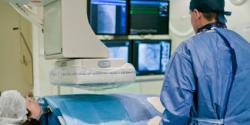Thoracic Aortic Aneurysm Treatment in Israel

A thoracic aortic aneurysm is an abnormal widening or ballooning of a portion of the thoracic artery caused by its wall’s weakness. Thoracic aortic aneurysms are most often asymptomatic and are usually detected accidentally during tests performed for other reasons (i.e. chest CT or X-ray or an echocardiogram).
When symptoms do present, they include:
- “Tearing" chest or back pain
- Shortness of breath, hoarseness and cough (due to pressure on lungs and airways)
- Difficulty swallowing (due to pressure on the esophagus)
- Hypotension
- Syncope
Types and Treatment Methods
A small aneurysm (up to 5 cm in diameter) usually requires only monitoring. Larger ones are, however, dangerous, and require immediate treatment as their rupture can result in life-threatening internal bleeding.
The purpose of treatment is to prevent the aneurysm from rupturing. The most common approach is an open chest surgery, during which specialists will remove the damaged portion of the artery and replace it with a special stent. Sometimes, several stents have to be inserted along the aorta, depending on the number of aneurysms detected and their length. This may impact the final price of the surgery.
In some cases, it is possible to treat an aneurysm by means of endovascular surgery, during which a synthetic graft is advanced through a leg artery to the site of the aneurysm.
Sample Treatment Program
In order to save time, it is strongly recommended that you send CT images displaying the aneurysm in advance of your arrival. This will allow local cardiologists and radiologists to assess it and draft a preliminary appropriate treatment plan.
Diagnostics:
- Laboratory tests
- High-resolution abdominal & pelvic angiogram (this will help determine the number of stents required and their caliber)
- Cardiologist and radiologist consultations
- Preoperative examinations (ECG, chest x-ray, anesthesiologist consultation)
When arranged in advance, all these procedures can be completed within just 1 day!
Treatment:
Surgery, which lasts about 3 hours, can take place on the following day. During an open procedure a cardiac surgeon then opens the chest. Patients are normally discharged 3 days later (one night of hospitalization in the intensive care unit and 2 in the cardiology ward).
In case of endovascular repair, contrast material is injected into the femoral artery at the start of the procedure and an interventional radiologist inserts the stent under X-ray control. The two common symptoms that appear following this type of surgery are fever and pain in the incision area; they also affect the date of discharge from the hospital. You will likely have a Doppler US scan to assess the condition of your femoral blood vessels.
Stiches are removed around postoperative day 10. If deemed necessary by your treating physician, a repeat angiogram will also be performed.

















 Toronto:
Toronto:  London:
London: 



